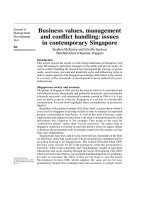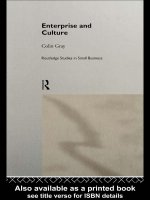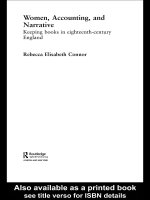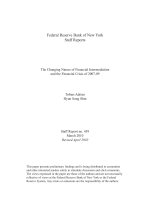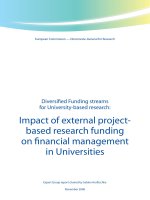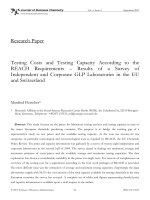Corruption and illicit financial flows in Nepal
Bạn đang xem bản rút gọn của tài liệu. Xem và tải ngay bản đầy đủ của tài liệu tại đây (268.94 KB, 14 trang )
CORRUPTION AND ILLICIT FINANCIAL FLOWS
IN NEPAL
Tara Prasad Bhusal*
ABSTRACT
In recent years, considerable intellectual interest has arisen over
the extent of illicit financial flows which may have development,
governance or other consequences for both developed and developing
countries. Illicit financial flows involve the cross-border transfer of the
proceeds of corruption, trade in contraband goods, criminal activities,
and tax evasion. The main objective of this article is to explore the current
situation of illicit financial flows from the developing countries with
special reference to south Asia and Nepal. The article also explains its
causes, impact and measures to stem those flows. Although much effort
and resources have been used to stem the illicit financial flows in the
world, it is in increasing trend specially in case of developing world.
Key Words: Illicit financial flows, corruption, money laundering, tax
havens.
INTRODUCTION
The term “illicit financial flows” is understood differently by
different stakeholders. At one end of the spectrum, IFFs are defined
strictly as capital flows that are illegal in the way they are created,
transferred, or utilized. Funds that are illegally earned, transferred or
utilized are called illicit financial flows (IFF). Global Financial Integrity
(GFI) classifies this movement as an illicit flow when the funds are
illegally earned, transferred, and/or utilized. Some examples of illicit
financial flows might include: A drug cartel using trade-based money
laundering techniques to mix legal money from the sale of used cars with
illegal money from drug sales; an importer using trade mis-invoicing to
evade customs duties, VAT, or income taxes; a corrupt public official
using an anonymous shell company to transfer dirty money to a bank
account in the United States; an human trafficker carrying a briefcase of cash
across the border and depositing it in a foreign bank; or a terrorist wiring
money from the Middle East to an operative in Europe (GFI, 2016).
Components of IFFs include: theft, bribery and other forms of corruption by
government officials, other criminal activities, including drug trafficking,
money laundering, racketeering and counterfeiting, international commercial
*
Mr. Bhusal is Reader in Economics at Central Department of Economics, Tribhuvan
University, Kirtipur, Kathmandu, Nepal.
212
CORRUPTION AND ILLICIT FINANCIAL...
transactions, including tax evasion, trade mispricing, over or under invoicing
etc. mostly involving multi-national corporations.
In the international development community, the concept of IFFs
is emerging as a powerful and constructive umbrella to bring together
previously disconnected issues. The term emerged in the 1990s and was
initially associated with capital flight. It now generally refers to crossborder movement of capital associated with illegal activity or more
explicitly, money that is illegally earned, transferred or used that crosses
borders. This falls into three main areas:
(a)
The acts themselves are illegal (e.g., corruption, tax evasion); or
(b)
The funds are the results of illegal acts (e.g., smuggling and
trafficking in minerals, wildlife, drugs, and people); or
(c)
The funds are used for illegal purposes (e.g., financing of
organized crime).
However, there is an ongoing global discussion on whether and what
commercial activities – such as tax avoidance – should be considered part of
IFFs, considering that many business practices to lower tax liabilities are
legal. So, while the term “illicit financial flows” is increasingly used, there is
still no agreement on the precise definition. The World Bank Group
recommends focusing on flows and activities that have a clear connection
with illegality. Regardless of how IFFs are precisely defined, it’s clear that the
flows are an impediment to development. What’s most important is to
understand how and why money flows out of developing countries and to
devise strategies to stem these flows (World Bank, 2016).
The concept of illicit financial flows is characterized by a lack of
terminological clarity, which in turn limits effective international
discourse and coalition-building as well as the development of adequate
policy recommendations. The OECD (2015 ) defines that the term illicit
financial flows as being generated by “a set of methods and practices
aimed at transferring financial capital out of a country in contravention
of national or international laws. In practice an ‘illicit financial flow’
ranges from something as simple as a private individual transferring
funds into his/her account abroad without having paid taxes on the
funds, to highly complex money laundering schemes involving criminal
networks setting up multi-layered multi-jurisdictional structures to hide
ownership and transfer stolen funds". The term capital flight is often
used synonymously for illicit financial flows.
Capital flight, however, refers to money flowing out of a country
in search for investment opportunities that are both secure and likely to
yield a high return on investment. This may be in response to an
unfavorable event in the country of origin or in anticipation of such an
TRIBHUVAN UNIVERSITY JOURNAL, VOLUME. XXX, NUMBER 2, DECEMBER 2016
213
event. Money leaving developed economies with high saving rates is
mostly termed as foreign direct investment, while capital flight usually
refers to money leaving developing countries. Capital flight might be licit
or illicit depending on the source of the capital and the method used to
transfer the money. While economists and international organizations
have discussed capital flows for decades 2, illicit financial flows have
only recently been receiving widespread attention.
REVIEW OF LITERATURE
Illicit financial flows are a consequence of inequity of the macroeconomy, and in turn make a large contribution to that inequity (Kar and
Cartwright-Smith, 2010; UNECA, 2014). Illicit flows are defined as “Money
that is illegally earned, transferred, or utilized” (Kar and Cartwright-Smith
2007, iv). It includes illegal capital flight but not substantively large legal or
‘licit’ capital flight, where flows are specifically in violation of laws and
regulations. Also, according to Global Financial Integrity, it does not
currently include criminal smuggling or proceeds derived from mispriced
asset swaps (Kar and Cartwright-Smith, 2007). According to UNECA,
estimates are low because they do not include the proceeds of smuggling or
the mispricing of services. The definition includes trade mispricing, but there
is a notorious difficulty in working out where the licit and illicit begin and end
when so many trade transactions take place between parts of the same firm
and where ‘arm’s-length’ pricing data is unavailable. This latter context is that
which defines trade pricing in much of the African natural resource sector,
which is both oligopolistic and opaque (Bracking and Sharife, 2014).
Baker (2005) generated the term IFFs to include unrecorded capital
flows from criminal corporate transfers and related practices, the proceeds of
corruption, and the proceeds of trade in illegal goods and in people. While
much focus goes to government corruption, Baker estimated that 60–65 per
cent of IFFs globally are generated through commercial transactions in
multinational corporations, particularly through trade mispricing. Thirty to 35
per cent are criminal such as trade in drugs, weapons and people, while five to
seven per cent are generated by corruption, defined in its boundary type as the
bribery of public officials. However, as Chaikin and Sharman (2009) note
“corruption and money laundering are symbiotic: not only do they tend to cooccur, but more importantly the presence of one tends to create and
reciprocally reinforce the incidence of the other. Thus many IFF components,
such as transfer pricing, are facilitated by corruption, such that its low
measurement might belie its importance or facilitation of the other categories
(UNECA, 2012).
Kar and Cartwright-Smith (2009) provided an estimation of the
volume and pattern of IFFs from developing countries by using a
combination of the World Bank Residual model and the Trade Mispricing
214
CORRUPTION AND ILLICIT FINANCIAL...
Model and two measures of net external indebtedness of the public sector
based on changes in the stock of external debt (CED) and the net debt flows
(NDF). They find that in 2006, developing countries lost an estimated
US$858.6 billion to US$1.06 trillion in illicit financial outflows. As worrying
as the global total was, over the five-year period of the study (2002 to 2006)
IFFs grew at a compound rate of 18.2 per cent. Dev and Cartwright-Smith
(2008) put illicit money flows from developing countries at between US$800
billion and US$1 trillion by 2006 (Palan et al., 2010).
Baker (2005) argued that half of this flows out of developing and
transitional economies and into major international banking centres. He
further estimates that 80 to 90 per cent is a permanent outward transfer,
but that some comes back as FDI having taken a ‘round trip’ (Baker,
2005). Illicit money annually and to date amounts to an estimated US$800
million to US$1.3 trillion (Palan et al., 2010).
OBJECTIVES AND METHODOLOGY
The main objective of the paper is to explore the concept of illicit
financial flow and present status of illicit financial flows of developing
countries and Nepal. This paper also tries to explore the impact of corruption to
the illicit financial flows as well as its impact in the economy. The methodology
adopted in this article is analytical and explanatory. This paper is based on the
secondary data published mainly by Global Financial Integrity.
FORMS OF ILLICIT FINANCING FLOWS
Illicit financial flows are often defined as the transfer of illegally
earned assets or the hiding of legally earned assets to facilitate illegal tax
evasion. The Eurodad (2016) report ‘Giving with one hand and taking
with the other: Europe's role in tax- related capital flight’ expanded upon
common definitions to include aggressive tax planning or tax avoidance.
The report explains the tax avoidance is a “technically legal activity that
results in the minimization of tax payments” and significantly
contributes to the volume of illicit financial flows. Illicit financial flows
take many forms and circulate through a global maze in which
ownership is obscured and profits, assets, and tax authorities become
lost. If one or more of the following conditions is fulfilled, then such
funds are considered to be illicit. The transfer itself is illegal; the funds
are proceeds of illegal activity; legal obligations relating to the funds,
such as payment of tax, have not been observed.
TRANSFER MISPRICING
This is used by large corporations to reduce their tax bill by
trading between two related companies. Goods are exported under
one invoice which is redirected to a tax haven. The price is then
altered on the invoice and sent to the importing country for payment.
TRIBHUVAN UNIVERSITY JOURNAL, VOLUME. XXX, NUMBER 2, DECEMBER 2016
215
This process shifts profits out of developing countries and reduces
the tax received by governments though either import-overpricing or
export under-pricing.
ROUND-TRIPPING
This is the practice whereby, profits located overseas return to
their country of origin disguised as foreign-direct-investment. By
obscuring ownership and origin companies are able to harvest the
favorable tax breaks offered to foreign direct investors.
HIDDEN OWNERSHIP
The complex architecture that allows for round-tripping is made
up of shell companies, foundations and trusts with nominal beneficiaries
that operate to exploit tax loop-holes by concealing who the actual owners
are. Profits directed through tax havens can then be disguised or laundered
and returned to their owner as profits legitimately earned.
INFORMAL FLOWS
Not all informal flows are illicit. Many cross-border flows are
legitimate remittances sent home by workers abroad through underground
banking systems. Such systems may be used simply due to difficulties faced
by such persons in opening bank accounts, or because the recipients of such
flows (typically poor relatives) have no bank accounts (McCusker, 2005).
CAPITAL FLIGHT
The term capital flight is often used as a synonym for illicit flows.
However, capital flight is generally understood as the movements of fund
abroad in order to secure a better return or protect them, often in response to
an unfavourable event in the country of origin (Kant, 2002). Capital flight
may be legal or illegal. In the former case – for example where an investment
fund transfers assets from domestic government bonds to safer government
bonds in a different country – capital flight will be recorded on the books of
the entity transferring the capital, and returns on the investment are likely to
return to the source country. Illegal capital flight tends to be unrecorded and
typically of proceeds of illegal activities – in other words illicit flows:
(i)
MONEY LAUNDERING: Money laundering is a process to disguise
the source of criminally derived proceeds to make them appear
legal. Money laundering is a specific legal concept that includes
only the proceeds of a set of predicate criminal offences, which
are defined by the laws of a given country. Funds originating from
other criminal offences may not be used to build a case of money
laundering in that particular country, although such funds may
well be illicit as defined by this paper. This is important for
practical purposes, as anti-money laundering regimes suffer from
the fact that the range of predicate offences on which a money
216
CORRUPTION AND ILLICIT FINANCIAL...
laundering prosecution may be based varies across countries, and
does not always include corruption and tax evasion. Put another
way, conflating illicit flows and money laundering may tend to
encourage over-reliance on anti-money laundering policy (AML)
to tackle illicit flows.
(ii)
TAX HAVENS: The term tax haven conjures images of tropical
islands but ‘secrecy jurisdiction’ is a more apt term as secrecy is the
service provided. “By providing high secrecy, tax havens are the
privileged destination of money from crime, the drugs trade and
corruption. But this is just the tip of the iceberg. A much bigger share
of activities taking place in tax havens are the result of legal
operators. Transnational corporations commonly use tax havens in
order to escape tax burdens and regulation as well as to disguise their
accounts and indebtedness levels. Big international banks and
insurance companies have subsidiary companies registered in tax
havens and most of the hedge funds and private equity funds are
registered in tax havens.”
CORRUPTION AND ILLICIT FINANCIAL FLOW
Corruption distorts public policies in that resources are allocated not
based on efficiency or internal rates of return but in favor of those who are
willing and/or able to bribe or pay kickbacks to public officials. Weak
governance spawns public corruption and encourages corporate malfeasance.
Public corruption typically involves the abuse of authority or trust for private
benefit. But this is a temptation indulged in not only by government officials
but also by rent-seekers in private enterprises and nonprofit organizations. In
general, poor governance provides greater latitude for corruption, both in the
public and private sectors, so long as the corrupt are convinced that they are
likely to get away with the loot. The misallocation of resources also hurts the
private sector because infrastructure tends to get neglected even as the corrupt
enrich themselves at the expense of the state. The impact on the poor is
particularly harmful because the siphoning of funds reduces resources for
social programmes and investments in the MDGs. The state of governance
and the extent and type of corruption will vary considerably from one LDC to
the next depending upon institutional weaknesses, cultural and historical
propensities, economic structure and policies, state of bureaucracy, etc.
Hence, the policies needed to strengthen governance and curtail the
generation of illicit funds would also vary depending on these factors.
SOURCES OF ILLICIT FINANCIAL FLOWS
Illicit financial flows have different sources. There are tax-related
components such as domestic tax evasion and avoidance, which become
an illicit financial flow if the proceeds are transferred across borders.
TRIBHUVAN UNIVERSITY JOURNAL, VOLUME. XXX, NUMBER 2, DECEMBER 2016
217
International tax evasion and avoidance is another component of illicit
financial flows, i.e. making deliberate use of a mis-match in different
countries’ tax systems. Transfer mis-pricing is a form of international tax
evasion and avoidance while at the same time being a method used to
transfer money across borders. Other components such as proceeds from
drug trafficking or domestic corruption that have illegally crossed borders,
are also part of these flows.
TAX-RELATED COMPONENTS
According to UNCTAD, as the economy became more globally
integrated, so did corporations. Globalization has resulted in a shift from
country-specific operating models to global business models which make
use of integrated supply chains and centralized management and line
functions either at the regional or the global level. The growing
importance of the service component of the economy, and of the eeconomy has made it much easier for businesses to locate many
productive activities to geographic locations that are distant from the
physical location of their customers. This has facilitated non- or low
taxation of economic activity, which artificially segregates taxable income
from the activities that generate it.
Tax evasion and avoidance: Tax avoidance could be a strictly legal
arrangement used to lower a taxpayer’s tax liability though contradicting the
intent of a country’s tax law. Tax evasion is an illegal practice where a
taxpayer hides income or information from the tax authorities thereby paying
less tax than he would be legally obliged. While tax avoidance may not be
illegal, it can be regarded as an abusive tax practice if it clearly violates the
intent of tax legislation and thus the will of elected parliaments.
Transfer mis-pricing: Transfer pricing refers to the mechanism by which
cross-border intra-group transactions are priced. This is in itself a normal
part of how an MNE operates. However, if the price that is charged between
different companies belonging to the same group does not reflect their true
economic value, and thus not at arm’s lengths, profits might effectively be
shifted to low-tax or no-tax jurisdictions and losses and deductions to hightax jurisdictions. This practice, commonly referred to as transfer mispricing, unfairly deprives a country of tax revenues thus reducing the
amount of resources available for funding public goods and services.
PROCEEDS FROM ILLEGAL ACTIVITIES
Proceeds from illegal activities are the money earned from illicit
activities. The activities that give rise to such proceeds can be purely domestic
activities, such as theft or corruption. However, as the world has globalized,
so has the crime. The proceeds from transnational organized crime such as
trafficking of humans, drugs, firearms and environmental resources (for
218
CORRUPTION AND ILLICIT FINANCIAL...
example wildlife and timber); product counterfeiting, maritime piracy,
migrant smuggling and cybercrime are both a source as well as a method of
an illicit financial flow. The activities giving rise to such proceeds will often
take place in developing countries but the proceeds will only materialize once
the products of such economic activity crosses borders (with the exception of
maritime piracy, where ransom is extorted).
ILLICIT FINANCIAL FLOWS FROM DEVELOPING COUNTIES
Report from Global Financial Integrity, “Illicit Financial Flows
from Developing Countries: 2004-2013,” finds that developing and
emerging economies lost US$7.8 trillion in illicit financial flows from 2004
through 2013, with illicit outflows increasing at an average rate of 6.5 percent
per year—nearly twice as fast as global GDP. During this ten-year period, the
developing world as a whole lost US$7.8 trillion in real terms, these flows
increased at 6.5 percent per annum. After a slowdown during the global
financial crisis, illicit outflows have been rising, topping US$1trillion since
2011 and reaching a new peak of US$1.1 trillion in 2013 (Table-1, GFI, 2016).
Table-1: Illicit Financial Flows from Developing Countries, by Region,
2004-2013 (in billions of U.S. $, nominal)
Region
2004
2005
2006
2007
2008
2009
2010
2011
2012
2013
Cumul
ative
SubSaharan
Africa
Asia
Developing
Europe
MENA+
AP
Western
Hemisphere
Total
32.5
51.9
56.4
77.0
78.6
85.0
78.0
74.3
66.7
74.6
675.0
Average
Share
8.6%
174.6
107.3
191.9
118.4
209.1
133.8
236.5
190.6
277.5
233.8
277.1
204.9
381.7
221.8
361.1
295.5
456.7
242.5
482.0
250.4
3,048.3
1,998.9
38.8%
25.5%
29.9
31.0
33.3
57.4
80.3
51.9
53.0
81.1
68.2
70.3
556.5
7.1%
120.9
131.4
111.0
137.7
157.8
128.1
172.0
195.8
201.8
212.8
1,569.3
20.0%
465.3
524.6
543.5
699.1
828.0
747.0
906.6
1,007.7
1,035.9
1,090.1
7,847.9
-
Sources: GFI, 2016.
From the Table-1, it is revealed that the illicit financial flows have
been increasing throughout from 2004 to 2013. It is also found that
developing countries of Asia occupies about 39 percent of illicit financial
flows. The Figure-3 also shows that Illicit Financial Flows from
Developing Countries during the period 2004-2013 is in increasing trend.
TRIBHUVAN UNIVERSITY JOURNAL, VOLUME. XXX, NUMBER 2, DECEMBER 2016
219
Figure-3: Illicit Financial Flows from Developing Countries: 20042013(in billions of U.S. $ nominal)
Source: GFI, 2016.
ILLICIT FINANCIAL FLOW IN SOUTH ASIAN COUNTRIES
India ranked top in the South Asian Illicit Financial Flows Index,
reporting illegal outflows of $510.29 billion in between 2004 and 2013,
followed by Bangladesh, which recorded illicit outflows of $55.88 billion
in the same period. Globally, $7.85 trillion worth of illicit financial flows
were reported in between 2004 and 2013, the report says.
Table-2: South Asian Ranking of Illicit Financial Flow
Country
South Asian
Ranking
Global
Ranking
Average Illicit
Financial
Outflow (million
US$)
IFF as
Percentage of
GDP
India
Bangladesh
Sri-Lanka
Nepal
Pakistan
Afghanistan
Maldives
Bhutan
1
2
3
4
5
6
7
8
4
26
53
86
109
115
120
132
51029
5588
1997
567
192
133
109
40
3.75333
5.25404
4.70886
4.2559
0.11248
1.08417
5.51958
2.45612
Source: GFI, 2016.
The Table-2 also shows that the percentage of average IFF to the GDP
of Maldives is 5.51 which is the highest in south Asia followed by Bangladesh.
220
CORRUPTION AND ILLICIT FINANCIAL...
ILLICIT FINANCIAL FLOWS AND NEPAL
Nepal recorded illicit financial outflows of $5.67 billion in
between 2004 and 2013, or average of $567 million per year, shows the
latest report, ‘Illicit Financial Flows from Developing Countries: 20042013’, released by Global Financial Integrity (GFI), a Washington, DCbased non- profit research and advisory organisation. In Nepal, of the total
money that flowed out in between 2004 and 2013, $5.39 billion, or 95 per
cent, was related to import under-invoicing, says the report (GFI, 2016).
Table-3: Illicit Financial Flow of Nepal, constant 2010 million US$.
Year
2007
2008
2009
2010
2011
2012
2013
Cumulative
Average
Illicit
Financial
Outflow
Hot Money
Outflows
Trade
misinvoicing
544
854
899
1,521
262
NA
NA
5,674
567
NA
107
NA
175
NA
NA
NA
282
28
544
747
899
1,346
262
NA
NA
5,392
539
Source: Global Financial Integrity, 2016.
GFI estimates that in 2013, US$1.1 trillion left developing
countries in illicit financial outflows. This estimate is regarded as highly
conservative, as it does not pick up movements of bulk cash, the
mispricing of services, or many types of money laundering (GFI, 2016).
IMPACT OF ILLICIT FINANCIAL FLOWS
Many empirical studies suggested that illicit financial flows are a
problematic phenomenon. Due to these flows, countries forfeit large
amounts of money. In fact, illicit financial flows drain resources and tax
revenues as well as foreign reserves. Illicit financial outflows drain hard
currency reserves, heighten inflation, reduce tax collection, cancel
investment, undermine trade, worsen poverty, and widen income gaps.
The followings are the major impacts of illicit financing flows.
(i)
Challenge on Political and Economic Security: IFFs pose a
huge challenge to political and economic security around the
world, particularly to developing countries. Corruption, organized
crime, illegal exploitation of natural resources, fraud in
international trade and tax evasion are as harmful as the diversion
of money from public priorities. Illegal logging, fishing and
mineral extraction are strongly connected with deforestation, the
depletion of fishing stocks and environmental degradation as well
as the impoverishment of individuals and communities who rely
on those resources to sustain their existence. Drugs counterfeiting
can have even more dire consequences, such as the thousands of
TRIBHUVAN UNIVERSITY JOURNAL, VOLUME. XXX, NUMBER 2, DECEMBER 2016
221
preventable deaths from malaria and tuberculosis due to substandard counterfeit drugs.
(ii)
Hampering Domestic Resource Mobilization: Domestic
resource mobilization (DRM) and IFFs are closely linked, as tax
evasion, the practice of illegally hiding income from tax
authorities and sending it abroad hampers government efforts to
mobilize domestic resources. Global estimates indicate that IFFs
are substantial and growing. IFFs are inherently difficult to
measure, given the illegality of the flows and their underlying
activities. While it’s difficult to quantify IFFs, there is widespread
agreement that the amounts involved are significant and growing
and that they pose deep problems, particularly in resource-rich
countries and fragile and conflict-affected states.
(iii)
Low Level of Investment and Capital Stock: The long-term
effects of such flows on economic growth may be just as
problematic. Lower levels of investment and a low capital stock,
due to money illicitly leaving the country, could hamper
economic development in the medium and long term. Money held
in secrecy jurisdictions that was moved to be hidden from local
tax authorities is no longer available for investments in the real
economy and subsequently distorts investment patterns. Commercial
activities are providing, due to their illegal nature, high returns crowd
out other economic activities and entrepreneurial ventures.
(iv)
Impact on Governance System: Another long-term consequence of
illicit financial flows is the impact that such flows have on a
countries’ governance system. The illegal activities that give rise to
parts of illicit financial flow and/or the illegal activities that are used
to transfer the money across borders undermine both the institutions
that are responsible for curtailing such flows (such as anti-money
laundering units, central banks, financial intelligence units, tax
administrations) and the democratic institutions that-willingly or due
to a lack of capacity fail to hold those responsible accountable.
Inevitably, tax revenues that are “lost” as companies are shifting their
profits and/or other illicit activities have to be compensated through
higher taxes on compliant taxpayers, such as small and mediumsized companies and individuals, severely compromising tax justice
and thus further damaging a country’s governance system.
MEASURES TO STEM ILLICIT FINANCIAL FLOWS
The objective is not to be exhaustive with regard to the various
methods used to generate and transfer illicit funds.GFI recommends a
222
CORRUPTION AND ILLICIT FINANCIAL...
number of steps that governments and other international regulators can
take to develop greater financial transparency and curtail illicit outflows.
(i)
Beneficial Ownership: Governments should establish public
registries of verified beneficial ownership information on all
legal entities, and all banks should know the true beneficial
owner(s) of any account opened in their financial institution.
(ii)
Anti-Money Laundering: Government authorities should adopt
and fully implement all of the Financial Action Task Force’s antimoney laundering recommendations; laws already in place should
be strongly enforced.
(iii)
Country-by-Country Reporting: Policymakers should require
multinational companies to publicly disclose their revenues,
profits, losses, sales, taxes paid, subsidiaries, and staff levels on a
country-by-country basis.
(iv)
Tax Information Exchange: All countries should actively
participate in the worldwide movement towards the automatic
exchange of tax information as endorsed by the OECD and the G20.
(v)
Trade Misinvoicing: Customs agencies should treat trade
transactions involving a tax haven with the highest level of
scrutiny. Governments should significantly boost their customs
enforcement by equipping and training officers to better detect
intentional misinvoicing of trade transactions, particularly through
access to real-time world market pricing information at a detailed
commodity level.
(vi)
Sustainable Development: The indicator for SDG goal 16.4 should
be country-level estimates of illicit outflows related to misinvoiced
trade and other sources based on currently available data, and the
International Monetary Fund or another qualified international
institution should conduct and publish the analysis annually.
CONCLUSION
Although much efforts and resources have been used to stem the
illicit financial flows in the world, it is in increasing trend specially in case of
developing world. The poorest developing countries including south Asian
countries will continue to rely on tariff revenues as a major source of
revenues given weak domestic taxation, and as long as such duties are levied,
smuggling will continue. In addition, the significant fiscal deficits in many
LDCs may well be driving tax evasion as higher deficits signal to private
markets that direct and indirect taxes may have to increase in the medium
term in order to close the gap. Even higher rates of economic growth
achieved by some LDCs in recent years could act as a driver of illicit capital
if growth is not accompanied by a better distribution of income.
TRIBHUVAN UNIVERSITY JOURNAL, VOLUME. XXX, NUMBER 2, DECEMBER 2016
223
These out flows are of serious concern, given inadequate growth,
high levels of poverty, resource needs and the changing global landscape
of official development assistance. Although Nepalese economies have
been growing at an average of about 5 per cent a year since the turn of the
century, this rate is considered encouraging but inadequate. It is, for
example, below the double-digit growth that has propelled transformation
in parts of Asia. Further, the benefits of this growth have mostly been
confined to those at the top of the income distribution and it has not been
accompanied by an increase in jobs.
The subject of illicit flows (like corruption) is clouded by a lack of
terminological clarity, which obstructs an effective policy debate. According
to all credible evidence, illicit flows are a phenomenon on a massive scale.
They have a major negative impact, particularly on developing countries,
while the net effect for rich democracies may well be positive. Illicit flows are
intimately linked to large-scale corruption. Acknowledgement of this is
important in order to clarify the extent and ways in which corruption may be
tackled via policies to stem illicit flows. Policies to tackle corruption through
addressing illicit financial flows have been focused primarily on anti-money
laundering (AML) policy. Current policies to tackle, prevent, or address
illicit flows and by implication to tackle corruption by hindering such flows –
should therefore be based on an evidence-based approach to policy selection,
a better balance between different policy instruments (including an emphasis
on good governance policies to prevent the corruption that yields illicit
flows), and an equitable allocation of the costs of implementing such policies
between rich and poor countries.
WORKS CITED
Baker, R.W. (2005). Capitalism’s Achilles Heel: Dirty money and how to
renew the free market system. Wiley, London.
Bracking, S. & Sharife, K. (2014). Rough and polished: A case study of
the diamond pricing and valuation system. Leverhulme Centre for
the Study of Value Working Paper Series.
Dev, K. & Cartwright-Smith, D. (2008). Illicit financial flows from
developing countries: 2002-2006. Washington, DC: Global
Financila Integrity, available from www.gfp.org.
Eurodad (2016). Official flows: basic principles for transparent
measurement and reporting by providers retrieved from
on 14september,2016.
Global Integrity Foundation (2016). Illicit financial flows, available from
/illicit-fnancial flows.
224
CORRUPTION AND ILLICIT FINANCIAL...
IMF & World Bank (2006). Reference guide to anti-money laundering
and combating the financing of terrorism, Second Edition and
supplement on special recommendation IX, Washington DC, US.
Kant, C. (2002). What is capital flight? The world economy, Vol. 25, pp
341-358, Oxford, UK.
Kar, D. & Cartwright-Smith, D. (2008). Illicit financial flows from
developing countries 2002-2006, Global financial integrity,
Washington
DC,
2009.
/>documents/executive%20- %20final%20version%2005-14-09.pdf
(accessed 22 December, 2016).
--- (2007). Illicit financial flows from developing countries, 2002–2006.
Washington, DC: Global Financial Integrity, Center for
International Policy.
McCusker, R. (2005). Underground banking: Legitimate remittance
network or money laundering system?, Trends and issues in crime
and
criminal
justice
No.
300,
July
2005,
8B6DC65F46C3FBE8%7Dtandi300.pdf (accessed 24
November, 2016).
OECD (2014). Illicit Financial Flows from Developing Countries:
Measuring
OECD
Responses.
Retieved
from
www.oecd.org/dac/SLM2013_issue%20paper%20illicit%20flows.
pdf assessed on 15 September, 2017.
Palan, R., Murphy, R. & Chavagneux, C. (2010). Tax Havens: How
globalization really works. Ithaca, NY: Cornell University Press.
Sharman J.C. (2009). The global anti-money laundering regime and
developing countries: Damned if they do, damned if they don’t ?,
paper presented at the annual meeting of the International Studies
Association, Town and Country Resort and Convention Center,
San
Diego,
California,
USA,
Mar
22,
2006,
/>/1/0/0/7/5/p100752_ind ex.html (accessed 16 May 2015).
UNECA (2012). United nations economic commission for Africa. High
level panel on illicit financial flows from Africa, Illicit financial
flows from Africa: Scale and Development Challenges.
Background Document.

